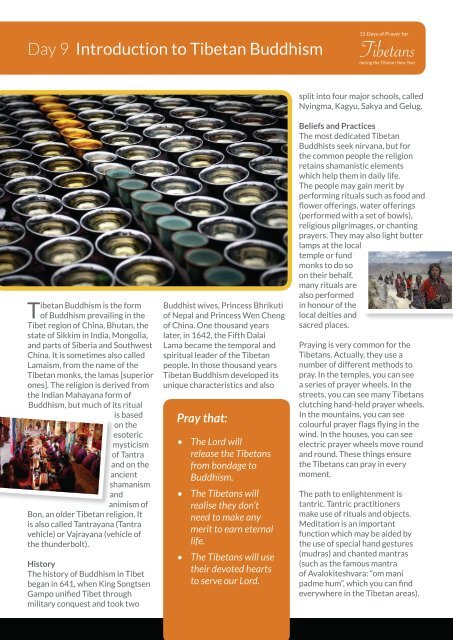You also want an ePaper? Increase the reach of your titles
YUMPU automatically turns print PDFs into web optimized ePapers that Google loves.
Day 9 Introduction to Tibetan Buddhism<br />
15 Days of Prayer for<br />
<strong>Tibetans</strong><br />
during the Tibetan New Year<br />
Tibetan Buddhism is the form<br />
of Buddhism prevailing in the<br />
Tibet region of China, Bhutan, the<br />
state of Sikkim in India, Mongolia,<br />
and parts of Siberia and Southwest<br />
China. It is sometimes also called<br />
Lamaism, from the name of the<br />
Tibetan monks, the lamas [superior<br />
ones]. The religion is derived from<br />
the Indian Mahayana form of<br />
Buddhism, but much of its ritual<br />
is based<br />
on the<br />
esoteric<br />
mysticism<br />
of Tantra<br />
and on the<br />
ancient<br />
shamanism<br />
and<br />
animism of<br />
Bon, an older Tibetan religion. It<br />
is also called Tantrayana (Tantra<br />
vehicle) or Vajrayana (vehicle of<br />
the thunderbolt).<br />
History<br />
The history of Buddhism in Tibet<br />
began in 641, when King Songtsen<br />
Gampo unified Tibet through<br />
military conquest and took two<br />
Buddhist wives, Princess Bhrikuti<br />
of Nepal and Princess Wen Cheng<br />
of China. One thousand years<br />
later, in 1642, the Fifth Dalai<br />
Lama became the temporal and<br />
spiritual leader of the Tibetan<br />
people. In those thousand years<br />
Tibetan Buddhism developed its<br />
unique characteristics and also<br />
Pray that:<br />
• The Lord will<br />
release the <strong>Tibetans</strong><br />
from bondage to<br />
Buddhism.<br />
• The <strong>Tibetans</strong> will<br />
realise they don’t<br />
need to make any<br />
merit to earn eternal<br />
life.<br />
• The <strong>Tibetans</strong> will use<br />
their devoted hearts<br />
to serve our Lord.<br />
split into four major schools, called<br />
Nyingma, Kagyu, Sakya and Gelug.<br />
Beliefs and Practices<br />
The most dedicated Tibetan<br />
Buddhists seek nirvana, but for<br />
the common people the religion<br />
retains shamanistic elements<br />
which help them in daily life.<br />
The people may gain merit by<br />
performing rituals such as food and<br />
flower offerings, water offerings<br />
(performed with a set of bowls),<br />
religious pilgrimages, or chanting<br />
prayers. They may also light butter<br />
lamps at the local<br />
temple or fund<br />
monks to do so<br />
on their behalf,<br />
many rituals are<br />
also performed<br />
in honour of the<br />
local deities and<br />
sacred places.<br />
Praying is very common for the<br />
<strong>Tibetans</strong>. Actually, they use a<br />
number of different methods to<br />
pray. In the temples, you can see<br />
a series of prayer wheels. In the<br />
streets, you can see many <strong>Tibetans</strong><br />
clutching hand-held prayer wheels.<br />
In the mountains, you can see<br />
colourful prayer flags flying in the<br />
wind. In the houses, you can see<br />
electric prayer wheels move round<br />
and round. These things ensure<br />
the <strong>Tibetans</strong> can pray in every<br />
moment.<br />
The path to enlightenment is<br />
tantric. Tantric practitioners<br />
make use of rituals and objects.<br />
Meditation is an important<br />
function which may be aided by<br />
the use of special hand gestures<br />
(mudras) and chanted mantras<br />
(such as the famous mantra<br />
of Avalokiteshvara: “om mani<br />
padme hum”, which you can find<br />
everywhere in the Tibetan areas).


